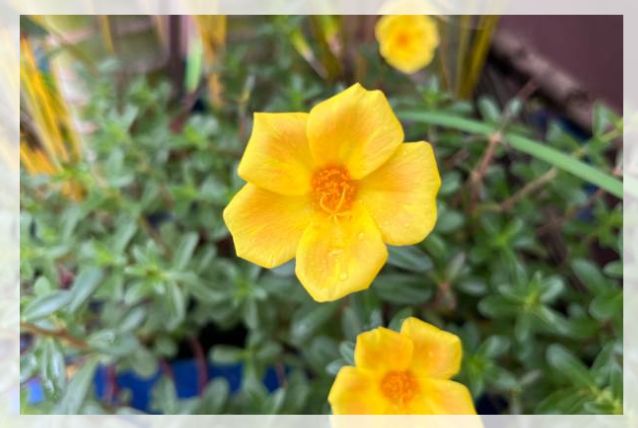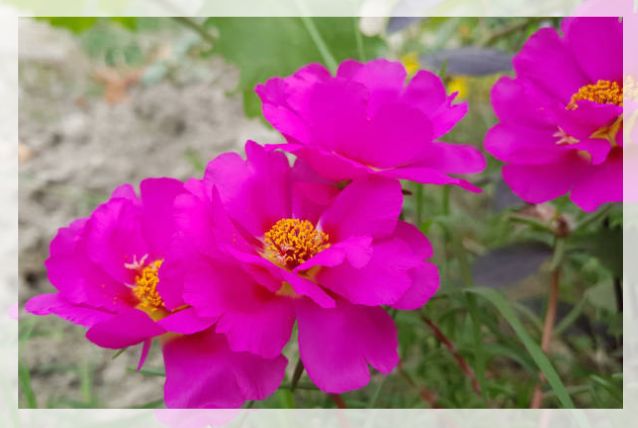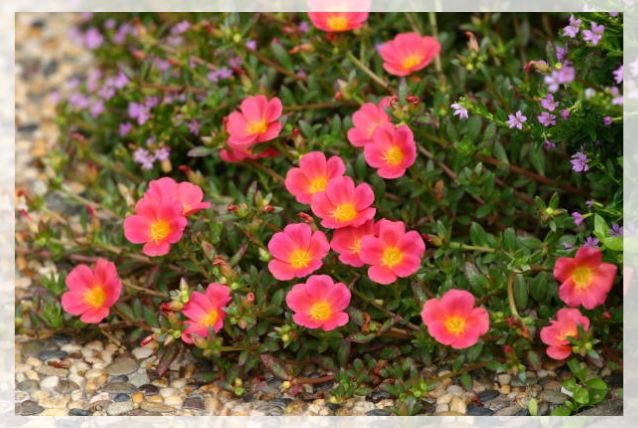There has been a growing popularity of succulents in recent years, and portulaca Grandiflora deserves a place in your landscape.
The cheerful flowers of portulaca grandiflora come in an array of pastel and vibrant tropical hues.
Moreover, they offer weeks of continuous bloom from summer to frost.
These plants are both heat and drought-tolerant, and this visually carefree plant loves to thrive in high heat and low-humidity conditions.
It is important to note that ornamental portulacas are closely related to purslane, portulaca oleracea which is an edible weed.
They are useful in a number of areas with poor soil where other plants struggle to grow, and is a versatile as a ground cover, bedding plant, in containers, or hanging baskets.
This fast grower tends to quickly fill in bare spots and is also attractive to bees and butterflies.
Keep on reading.
Portulaca Grandiflora
Moss rose plants or Portulaca Grandiflora is a popular flowering annual succulent that does not tend to come back every year.
These plants are native to South America and tend to grow to be between 3 and 9 inches tall and spread to create a dense mat, making them a good option for a succulent ground cover.
The flowers of this plant come in a number of bright colors and often have ruffled petals that look very similar to miniature roses.

The blooms tend to grow in clusters or reddish stems and often do not open on cloudy days or nights.
The best time to plant moss rose is in spring after the danger of frost has passed.
As a gardener, you should carefully consider when you plant moss roses in your landscape, as all parts of the plant are toxic to cats and dogs.
Learn more about Poisonous Plants for Pets here.
Quick Facts about Portulaca Garndiflora
Some quick facts about portulaca grandiflora are:
| Common Name | Moss rose, moss rose purslane, Mexican rose, the sun rose, rock rose |
| Botanical Name | Portulaca grandiflora |
| Family | Portulacaceae |
| Plant Type | Annual flowering succulent |
| Mature Size | 3–8 in. tall, 6–12 in. wide |
| Sun Exposure | Full |
| Soil Type | Sandy, well-drained |
| Soil pH | Neutral to Acidic |
| Bloom Time | Early summer to frost |
| Flower Color | White, orange, yellow, red, pink |
| Hardiness Zones | 2–11 (USDA) |
| Native Area | South America |
| Toxicity | Toxic to dogs, toxic to cats |
Portulaca Grandiflora Care
You can find them in spring and if you see leftover moss rose plants on clearance sale, in the summer, you may notice the plants are often as lovely as they are in spring.
This is a testament to the toughness of the plant
The medium green, cylindrical, succulent leaves of portulaca grandiflora are another clue of the hardiness of the plant, namely its tolerance to drought conditions.
Moreover, moss rose plants are often a popular choice for growing in a container garden, also the front edge of the garden bed borders, as edging along paved walkways, on top of stone wats, and in rock gardens.
Additionally, their trailing habit works well in hanging baskets.

These plants will not spread fast outside of their bounds as a ground cover, so they are ideal for small gardens.
It is important to note that these plants tend to grow in poor, dry soils, where many other plants may struggle.
In fact, soil that is too wet can actually kill portulaca grandiflora.
Moss roses often bloom from summer to the first frost of the fall without any deadheading required.
As annuals, the plants, however, tend to die at the end of the growing season, but they do produce seeds that can potentially germinate and sprout the following year.
Learn more about the Germination of Seeds here.
Light and Soil Requirements
Portulaca grandiflora tends to thrive in full sun, at least six to eight hours on most days to look and bloom their best.
However, if you try to grow them in shady areas, they will fail to produce flowers and the flowers will most likely not open as well.
Moreover, these plants tend to thrive in sandy and rocky soil.
They will need excellent drainage soil as well.
If your garden bed has clay soil, you can grow moss roses in containers rather than trying to improve the clay soil drainage.
Soil that retains too much water can easily cause your plant to die.
Water, Temperature, and other Requirements
Portulaca Grandiflora has low moisture needs, although they are not quite as drought tolerant as cacti.
These plants can tolerate periods of dryness, however, flowering tends to be better with some well-draining soil moisture.
Moreover, if you plan to water the plant, make sure you have a long stretch without a waterfall as a general rule of thumb, one deep watering per week during hot summer is enough for the plant.
A native of Brazil, Uruguay, and Argentina, portulaca grandiflora likes to thrive in high heat and low humidity.
This plant can tolerate cool, moist spring weather as long as it is frost-free.
However, the best growth and blooming will not occur until the summer heat comes along.
Moss rose is first tender and will die back in winter, likely at the first deep freeze, if not earlier.
Moreover, these plants can tolerate lean soil they will often not need fertilizer.
However, when you feed the plant with a balanced, slow-release fertilizer at the time of planting, it can help promote healthy growth and profuse flowering.
You can also fertilize twice during the growing season of the plant, and use a blend that is high in phosphorus for more stunning blooms.
Types of Moss Rose
There are a number of different types of portulaca grandiflora, that are popular for landscape gardens.
These include:
‘Afternoon Delight’: This varietal comes in 2-inch wide blooms that are open all day until the evening, which is longer than most other varietals.
‘Calypso Mix’: This features double blooms in orange, yellow, and red.
‘Duet’ series: This varietal boasts bicolor flowers in yellow and red or yellow and pink.
‘Fairy Tale’ series: These varietals with snakes like ‘Snow White’ and ‘Sleeping Beauty” resemble bomb-type, peonies.

These have flowers that have a pom-pom center with flat petals that flare around the edges.
‘Happy H0ur’ series: These are called so as these varietals like ‘Banana’ and “coconut’ tend to bloom earlier than other types.
‘Mojave’: This one tends to have large blooms that come in tangerine, pinks, yellows, and whites.
‘Sundance’: These tend to feature more petals on each flower and blooms also stay longer than other varietals.
‘Sundial’series: This is a varietal that blooms earlier and tolerates cloudy days and cool weather than other varieties.
Moreover, varietals like ‘Sundial White’, ‘Sundial Yellow’, and ‘Sundial Peppermint’ come in bold pink and white striped flowers.
‘Tequila’ series: A number of colored hybrid blooms like red blowers with yellow centers, tend to bloom early and tolerate cooler, moist conditions.
‘Yubi Summer Joy’ series: These are trailing flowers that stay open later in the day than most other varietals.
Pruning and Propagating Tips and Techniques
At most, portulaca grandiflora will need light pruning, and only if you live in a zone where they can survive year-round.
The best time to prune moss rose is in the early spring before new growth begins to emerge.
Moreover, remove any growth that looks dead or diseased, and you can also think of a dense plant to improve air circulation.
This can help to reduce the risk of fungal disease.
While deadheading the spent blooms of the plant is not necessary.
Like most succulent plants, you can easily propagate portulaca grandiflora through cuttings.
In fact, the cuttings tend to root readily and you will find success with this propagation method.
Here is how you can do it:
- with the help of shape, and clean shear, make a cutting from a mature, established ‘mother’ plant that has bloomed for at least one season
- the cutting should be at least 4 inches in length and inches of at least one node
- remove all leaves and flowers from the cutting
- place the cutting in a small bowl of water as you prepare the rest of the materials
- in a small pot, combine a moist, but well-draining mixture of sand, soil, and peat moss
- bury the stem cut-side down at least three inches deep into the soil
- cover the pot with a plastic bag or some means of trapping the humidity
- move the cutting to a place that gets bright filtered light and maintains a temperature between 65 and 75 degrees Fahrenheit
- water occasionally, just to make the soil moist
- cutting should root within two weeks at that point you can care for typical moss roses
Growing Moss Rose from Seeds
If you are growing portulaca grandiflora from seeds, you can either start them indoors, 6 to 8 weeks before the projected last frost date.
Or you can plant them in ground after the last frost in your area.
Add the seeds to slightly moist soil and cover them lightly, as they will need light to germinate.

Moreover, maintain slight soil moisture until the seedlings emerge.
Germination will take about two weeks, and then water the plants only when the top inch of the soil is dry.
Keep the seedlings by a bright window if you are growing them indoors.
Common Pests and Plant Diseases
Portulaca grandiflora is not affected by any notable pests or plant diseases.
Though aphids can occasionally bother these plants, especially in the spring.
With these pests, you may notice a sticky substance on the leaves.
Moreover, you can also see yellowing and wilting of the foliage.
To treat them, spray the affected plants with insecticidal soap.
Learn more about What Do Yellow Leaves Mean: Common Causes here.
Getting the Plant to Bloom
If you are struggling to get your portulaca grandiflora to bloom or if they are not producing bountiful enough blooms, the problem lies in the moisture levels of the soil.
These plants do not like to thrive in wet or soggy soil and when you plant them in a medium that retains too much moisture, it will cause them to cease blooming.
Try stepping back from the watering cadence, or you can repot the plant into the container, which naturally drains faster than the ground would.
Moreover, clay or terracotta pots can help wick excess moisture from the soil.
Another important factor when it comes to these plants’ bloom is to make sure they get enough sunlight.
Moss roses like to thrive in ample light and hot conditions and even an hour or two of shade can make the difference between bountiful blooms and barely any buds.
Thus, make sure your plant gets at least six to eight hours of direct sunlight daily.
However, if you are growing it with other plants, you may need to trim back new specimens so they do not block the light.






Leave a Reply